Fermenting Beer with Wyeast 3725-PC Bière de Garde Yeast
Published: October 21, 2025 at 7:23:19 AM UTC
This article serves as a comprehensive guide for homebrewers looking to brew bière de garde with Wyeast 3725-PC. It combines a detailed review of the yeast with practical steps for fermenting, handling yeast, making mash decisions, treating water, and packaging. The aim is to assist homebrewers in creating a malt-forward, clean, and slightly fruity French ale. This beer should align with BJCP standards.
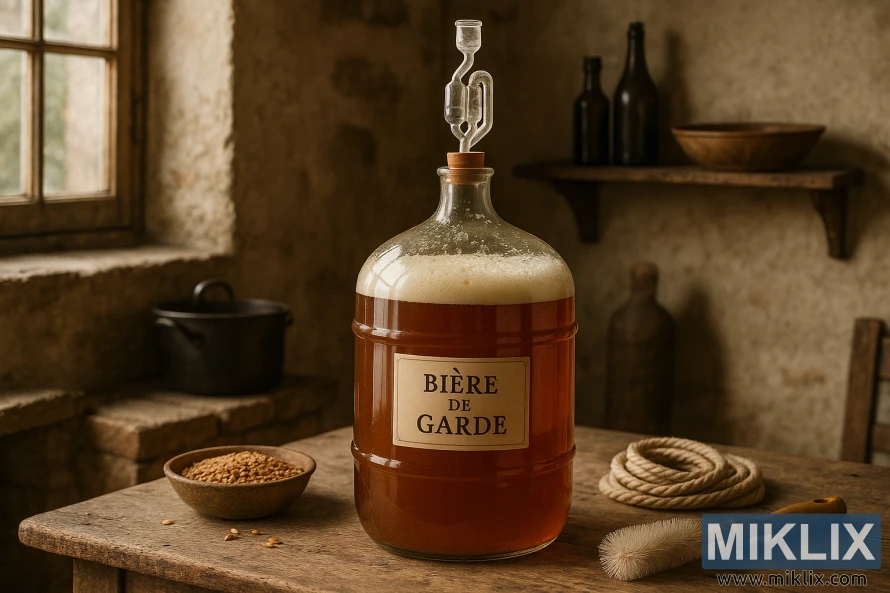
Readers will gain insights into the style, including fermentation schedules, pitching, and temperature strategies. The guide also offers alternatives when Wyeast 3725-PC is hard to find. It draws on the experiences of brewers and vendor notes to provide actionable advice for a consistent bière de garde.
Key Takeaways
- Wyeast 3725-PC Bière de Garde Yeast is pitched here as a strong option for authentic French farmhouse ales.
- Fermenting bière de garde benefits from cool ale temperatures or warm lager-style rests for a clean profile.
- Proper yeast handling and adequate cell counts prevent off-flavors and ensure attenuation.
- Malt-forward grain bills and conservative hopping highlight the style’s balance.
- Alternatives and practical substitutions are discussed for seasonal availability issues.
What is Bière de Garde and its historical context
Bière de garde originated in northern France, near Belgium, in the Hauts-de-France region. It was brewed seasonally by farmers as a provision beer to last through warmer months. The term "garde" translates to "keep" or "store," reflecting its original purpose.
In the 20th century, bière de garde transitioned from farmhouse cellars to commercial breweries. Brasserie Duyck, the maker of Jenlain, was instrumental in this transformation. The Jenlain history reveals how the beer evolved into a stronger, more refined product in the mid-1900s. Other breweries like La Choulette and Castelain also contributed to its modern profile.
The 1970s and 1980s saw bière de garde gain recognition as a distinct style. Brewers standardized recipes, aiming for an original gravity of 1.060–1.080 and a final gravity of 1.008–1.016. The color ranges from SRM 9 to 19, with bitterness between 18–28 IBU. Alcohol content typically falls between 6 to 8.5% ABV.
Bière de garde, while sharing farmhouse roots with saison, has a distinct character. It is known for its malty, smooth, and dry profile, with restrained hop and yeast notes. Saison, on the other hand, is hoppier and more yeast-forward, featuring spicy and phenolic traits. Brewers focus on malt-forward approaches and controlled fermentation to achieve a dryness without excessive esters.
The style's development was influenced by local ingredients. Malteries Franco-Belge and Castle Maltings supplied regional malts, while Poperinge hops contributed classic European varieties. These elements, combined with traditional cellar storage practices, define the bière de garde's unique sensory profile.
Exploring bière de garde's history reveals a blend of farmhouse tradition and postwar commercial revival. Jenlain's history exemplifies this transition from a local provision beer to a symbol of the French farmhouse beer revival.
Style profile and sensory expectations for Bière de Garde
Bière de Garde is known for its malty yet dry character. Brewers aim for a balance that enhances drinkability. The BJCP 24C defines it as a malt-forward beer with a medium to medium-light body. It has a lean finish, ensuring sweetness is kept in check.
The aroma often features toasty and biscuity notes. Amber or brown versions may include light caramel, while paler ones might have a hint of herbal or spicy hop. Yeast can introduce subtle fruity esters, but phenolic or saison-like spice is rare.
Bitterness is kept low, usually between 18–28 IBU. This supports the malt without making the beer taste overly sweet. Pale versions might have a bit more herbal hop character, yet remain malt-forward.
Clarity and conditioning are crucial for the style. Bière de Garde should have a clear appearance, good head retention, and a smooth, well-lagered mouthfeel. Any cellar or musty notes are signs of cork aging faults, not authentic traits.
Alcohol levels typically range from 6 to 8.5% ABV in modern interpretations. Stronger bottles might offer a light alcohol warmth. Yet, the overall flavor profile demands that this warmth remains balanced, not overpowering the palate.
Wyeast 3725-PC Bière de Garde Yeast
Wyeast 3725-PC is touted as a genuine Bière de Garde strain. It's frequently recommended in style guides and brewer forums. Brewers commend its skill in highlighting malt flavors while keeping esters in check. This balance ensures the beer remains malt-forward without veering into harsh phenolic territory.
Its availability, though, poses a significant challenge. Wyeast seasonal strains like 3725 are often released for brief periods, typically in winter. Homebrewers eagerly await its re-release, which usually occurs from January to March.
Fermentation with this culture benefits from cooler ale temperatures for a clean profile. When kept cool, Wyeast 3725-PC enhances the dry, rounded malt flavors characteristic of the style. Warmer ferments, on the other hand, can introduce fruity or wine-like notes, making temperature control crucial.
Practical handling tips from the community are invaluable. Pitching adequate cell counts and avoiding high ale temperatures helps minimize phenolics. A brief conditioning or light lagering can also soften harsh edges and round out the flavor.
For those looking for alternatives, Wyeast 3725-PC shares similarities with strains like White Labs WLP072 French Ale and other farmhouse strains. These options offer a similar malt-forward, restrained ester profile when 3725 is out of season.
- Pitch at healthy cell counts for clean attenuation.
- Ferment on the cool side of ale ranges for minimal phenolics.
- Condition or lager briefly to smooth flavors and clarity.
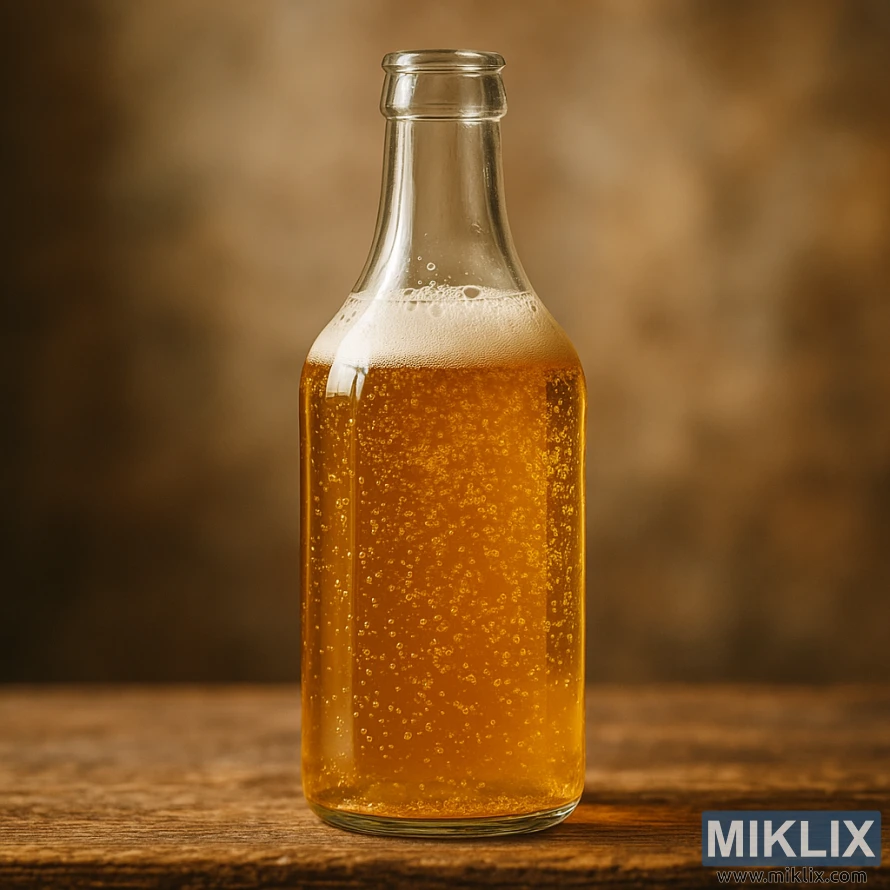
Yeast selection alternatives and recommended substitutions
Choosing the right yeast is crucial for the flavor and aroma of bière de garde. Brewers often look for alternatives to Wyeast 3725 when it's not available or they want a different profile. Strains that are clean and malt-forward are best for authenticity.
White Labs WLP072 and WLP011 are good ale options. WLP072 provides a gentle French ale character that preserves malt depth. WLP011 offers clean attenuation and works well when fermented cool.
German and Kölsch strains like WY1007 and WY1728 are practical substitutes for clarity and moderate ester production. WY1007 produces a neutral backbone that highlights malt, making it a common pick for farmhouse-style beers.
Some brewers report success with WLP570 and Alt strains for a richer malt profile. WLP570 can add subtle fruitiness while keeping the finish smooth. These strains suit recipes that benefit from a touch more complexity.
Lager yeast can produce an extremely clean result. SafLager W-34/70 and similar lager strains deliver crispness that complements malt. Fermenting a lager strain at warmer-than-normal lager temps, around 55–60°F (13–15°C), can simulate the ale-yet-clean character many brewers seek.
- White Labs WLP072 — French ale character, malt-forward.
- WY1007 — German Ale, neutral and malt-retaining.
- WLP570 — adds subtle fruit without dominating the profile.
- SafLager W-34/70 — clean lager finish when fermented a bit warm.
- WLP011 — clean attenuation, performs well at cooler ale temps.
Avoid strongly phenolic saison strains unless aiming for a hybrid beer. Saison yeast like WY3711 can become too peppery if fermented warm. If using a saison strain, keep temperatures low and monitor phenolic esters closely.
Phil Markowski’s lineup of clean ale strains is useful guidance. WLP003, WLP029, WLP011, WLP008, and WLP001 rate highly for clean profiles when fermented cool. These strains can produce bière de garde-like results with careful temperature control and a period of lagering.
Practical substitutions include WY1007, WY1728, and WLP570 for those seeking readily available alternatives to Wyeast 3725. Choose a strain that retains malt presence and attenuates cleanly. Ferment cooler than typical ales and consider a short lagering rest to smooth out esters and yeast character.
Pitching and yeast handling best practices
Creating a solid base is crucial. For bière de garde with an original gravity of 1.060–1.080, a robust yeast starter is essential. It boosts cell counts and shortens the lag phase. For session beers, a small starter is sufficient. But for larger, malt-forward batches, a bigger starter is needed.
When using dry yeast like SafLager W-34/70, follow the rehydration instructions carefully. For liquid yeast from Wyeast or White Labs, handle it gently to avoid excessive agitation. This protects the yeast and minimizes the risk of off-flavors during the early fermentation stages.
Oxygenation is key when pitching. Aerate the cooled wort just before adding yeast. This provides the necessary oxygen for the cells to build sterols and membranes. Proper oxygenation ensures a clean, efficient fermentation, preventing residual sweetness.
Pitch at the intended fermentation temperature, not at room temperature. Transferring yeast into wort at the same temperature as the fermentation target reduces thermal shock. This helps prevent unwanted phenolic or solvent-like esters. Cooler temperatures favor cleaner profiles, while warmer pitches can speed up activity but increase ester risk.
- Sanitize all contact surfaces and maintain a tidy pitching schedule.
- Use slightly higher pitch rates for very clean, quick fermentations that keep ester levels low.
- Plan a diacetyl rest for lagered versions if using lager strains.
If Wyeast 3725 is not available, choose a suitable substitute in advance. Adjust your starter size to match the substitute strain’s viability and attenuation. Matching cell counts and oxygenation needs ensures the beer stays true to style.
Monitor fermentation early and watch the gravity drop. Healthy, well-handled yeast reduce fermentation stalls and offer more control over flavor development. Good yeast starters, careful rehydration, the right pitching temperature, and proper oxygenation for bière de garde all contribute to a reliable fermentation and a better final beer.
Fermentation temperature strategies for Bière de Garde
Bière de garde thrives with a deliberate and steady fermentation temperature. Many brewers prefer fermenting cool ales at 55–60°F (13–15°C). This approach highlights malt character and keeps esters in check. The result is a clean, rounded profile with toasty malts and subtle fruit notes.
One reliable method is to use an ale strain and ferment at cooler temperatures. Aim for 55–58°F (13–14°C) during primary fermentation. This method reduces phenolic or peppery traits, keeping the beer focused. Fermenting at these temperatures also limits spicy saison-like characteristics while ensuring full attenuation.
An alternative is to employ a lager strain and ferment slightly warmer than usual. Running lager at warm temps of 55–60°F (13–15°C) results in a crisp, dry backbone with minimal ester presence. After primary, cool down and lager near 32°F (0°C) for several weeks. This step smooths the beer and clarifies flavors.
- Start at your chosen target and hold steady through active fermentation.
- Allow the yeast to finish at that temperature before any ramping.
- After primary, drop temperature gradually and condition cold for 4–6 weeks.
Effective temperature control is more crucial than extreme temperatures. A stable environment prevents off-flavors and ensures consistent results. Many brewers achieve the perfect balance by choosing either an ale strain at lower-than-normal ale temps or a lager strain at the higher end of lager temps. This balances freshness with smoothness.
Timing is key. Begin at your target temperature, allow full primary fermentation at that level, and then cold-condition to refine the palate. Consistent temperature control during these phases results in a classic bière de garde. This beer is malt-forward, clean, and well-conditioned.
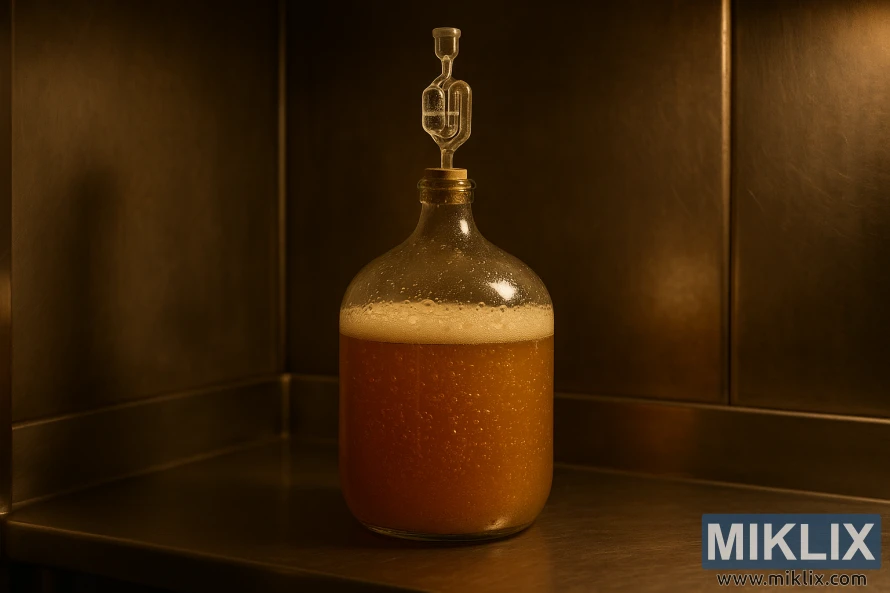
Mash schedules and techniques to achieve the style’s dry malt profile
A classic step mash offers precise control over enzyme activity, crucial for a lean, dry Bière de Garde. Traditional brewers follow a specific sequence: start with a protein rest at 131°F (55°C) for 10–20 minutes. Then, raise the temperature to a beta-amylase rest at 144°F (62°C) for about 30 minutes. Finish with an alpha-amylase rest at 158°F (70°C) for 10–20 minutes. To stop conversion, mash out near 168–170°F (76–77°C).
This mash schedule enhances fermentability while preserving enough malt character. It allows for subtle toasty and caramel notes. The beta/alpha rests sequence optimizes sugar breakdown, promoting higher attenuation. This is achieved by providing ample fermentable maltose and some longer dextrins for balance.
When step mashing is not possible, a single infusion at roughly 152°F (67°C) is effective. Aim for a mash thickness of 1.25–1.5 quarts per pound for consistent enzyme action. A slightly lower infusion temperature can lead to a drier finish without sacrificing flavor.
Be cautious with adjuncts. Commercial breweries might add up to 10% sugar to increase dryness and attenuation. Homebrewers often prefer to avoid sugar to maintain malt depth. The choice depends on the desired flavor profile.
Ensure early recirculation and slow sparging to prevent tannin pickup. Controlled lautering and moderate mash thickness are key to maintaining a clean, fermentable wort. These practices, combined with a targeted mash schedule, refine the beer's profile and support the desired attenuation.
Grain bills and ingredient choices for authenticity
Begin with authentic malts if possible. Malteries Franco-Belge and Castle Maltings are quintessential sources for northern French bière de garde. If these are not accessible, opt for high-quality German or Belgian pale malts as alternatives.
For a Jenlain clone recipe, focus on a pilsner or pale malt base. Add Vienna and Munich malts in abundance to achieve toasty, bready flavors. Munich Vienna malts are crucial for the warm, biscuity flavor characteristic of amber variants.
Use specialty malts judiciously. Incorporate small amounts of crystal malts in the 20–60°L range for caramel notes. A touch of debittered black malt, like Carafa III, can enhance color without introducing harsh roast flavors.
- Example grist for a 5-gallon batch: Pilsner/pale malt + Vienna + Munich II + light Caramel Vienna (20°L) + Caramel Munich (60°L) + trace Carafa III.
- Target: OG ≈ 1.067, SRM ≈ 14, ABV ≈ 7.1% for a classic amber rendition.
Sugar can be used sparingly. Commercial versions may include up to 10% sugar to enhance fermentability and dry the finish. Homebrewers often choose to omit this to preserve the malt-forward profile.
Hop and adjunct choices should remain subtle. Traditional French hops like Strisselspalt are ideal. German or Czech noble varieties and English Fuggle are acceptable substitutes, offering a slightly earthy tone.
When crafting your bière de garde grain bill, balance is paramount. Allow Munich Vienna malts to dominate the flavor, limit crystal and roast, and select hops that enhance the malt character.
Hop choices and bitterness targets for Bière de Garde
Keep bitterness in check to highlight malt flavors. Aim for a bitterness range of 18-28 IBU. Many amber recipes fall around 20 IBU. This balance ensures toasty and caramel malts take center stage, supported by a clean backbone.
Opt for traditional bière de garde hops for authenticity. Strisselspalt adds gentle floral and herbal notes, fitting the style perfectly. Brewer’s Gold is great for early bittering, adding a slightly resinous edge. For a neutral alpha source, consider Magnum or a high-alpha bittering hop to hit your target IBUs.
Adopt a conservative hopping schedule. Place the primary bittering addition at the start of the boil to achieve the desired bitterness range. Only make minimal late additions at 10–15 minutes for subtle aroma. Avoid excessive late hopping, as it can shift the balance away from malt complexity.
Match your hop choice to the beer's color and yeast character. Paler versions can handle more herbal or spicy notes from Strisselspalt or German noble substitutes. Amber and darker beers, on the other hand, rely on malt depth. Keep hop additions low to ensure Brewer’s Gold or English Fuggle remain in the background.
- Primary bittering: Magnum or Brewer’s Gold to reach IBUs.
- Flavor/aroma: Small late additions of Strisselspalt or noble hops.
- Substitutes: German/Czech noble hops or English Fuggle for earthy notes.
When substituting, choose hops that complement Wyeast 3725 esters. Light herbal hops enhance delicate yeast esters in pale versions. Stronger, more aromatic hops can overpower malt in amber beers. Scale back additions and adhere to the bitterness 18-28 IBU guideline.
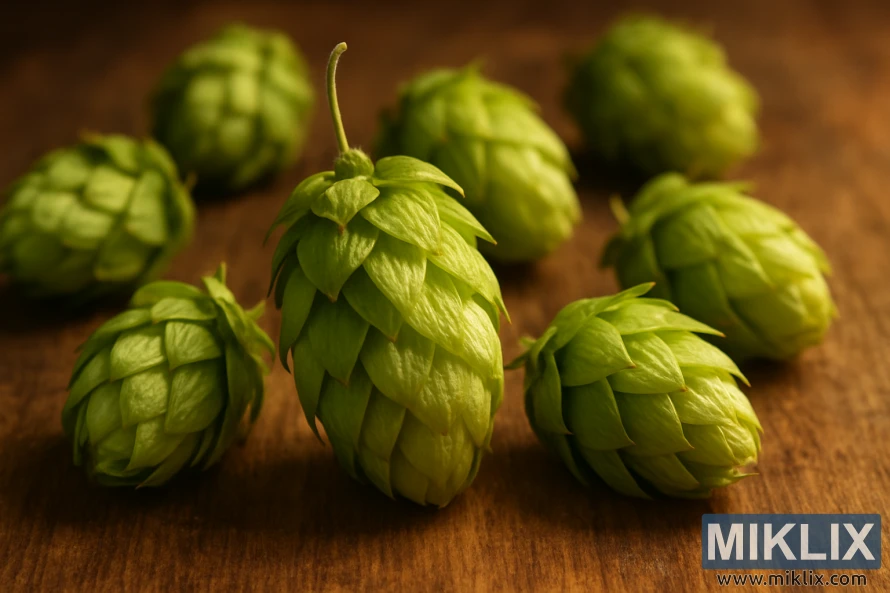
Water profile and treatment to highlight maltiness
Traditional French brewing water for bière de garde trends toward soft water brewing with low carbonate levels. This gentle base allows malt flavors to shine without harshness. Homebrewers often start with reverse osmosis or distilled water, then add minerals to tailor it.
Begin by testing your source water. If it's too alkaline, you'll need to reduce carbonates to avoid soapy flavors. To keep the mash pH sweet, brewers often use phosphoric acid or food-grade lactic acid at mash-in, aiming for a pH of 5.5.
Adding simple salts can enhance maltiness. For a five-gallon batch, one teaspoon of calcium chloride in the mash boosts malt character and enzyme performance. But, avoid high sulfate levels, as they can make the beer dry and emphasize hops over malt.
It's crucial to measure mash pH after dough-in, if possible. Aim for a pH between 5.3 and 5.6 to optimize enzyme activity. This will give your beer a clean, slightly dry finish, fitting the style. Adjustments should be made in small steps, with frequent pH checks to maintain balance.
Gordon Strong and other respected authors recommend starting with an RO base, adjusted to a soft profile. Fine-tune it to mash pH 5.5 and add modest calcium for a malt-forward beer. Use gentle treatment, precise pH checks, and conservative salt dosing to preserve the classic bière de garde malt focus.
Fermentation timeline and lagering recommendations
Begin with a full primary fermentation at the chosen temperature. For a cool ale profile, maintain 55–60°F until the specific gravity stabilizes. When using lager yeast at higher lager temperatures, aim for a similar 55–60°F range for clean fermentation.
Primary fermentation typically lasts one to two weeks, depending on yeast strain and original gravity. Rack to a secondary or carefully transfer off the heavy trub once fermentation is complete. This step minimizes off-flavor production and prepares the beer for cold conditioning.
After racking, plan for a cold-conditioning phase to enhance clarity and smoothness. Many brewers follow a 4-6 week lager schedule near freezing to round flavors and settle proteins. For a traditional finish, a 4-6 week lager at near 32°F is recommended.
To achieve that cold snap, crash to 32°F for a few days to help cold break and clear the beer. This step tightens yeast and particulate flocculation, making subsequent conditioning more effective. Extended conditioning time beyond the initial period will further refine mouthfeel and reduce harsh esters.
When ready to package, choose between bottle conditioning or kegging. For bottles, prime and allow adequate conditioning time to reach target carbonation. For kegs, force carbonate to about 2.5 volumes CO2 for a classic presentation. Adjust priming sugar carefully by batch size to avoid overcarbonation.
- Primary: 1–2 weeks at chosen temp until FG stable.
- Post-primary: transfer off trub, chill and settle.
- Lagering: target a 4-6 week lager near 32°F for smoothing and clarity.
- Final: crash to 32°F, condition, then carbonate to ~2.5 vols CO2 or bottle condition with proper priming.
Cold lagering is central to the classic smooth character noted by BJCP and brewing authorities. Even versions fermented as warm ales benefit from a disciplined beer rest and sufficient conditioning time to reach a rounded, clean profile.
Common fermentation issues and troubleshooting with 3725
Fermenting with Wyeast 3725 can yield a clean bière de garde when you control pitch rate, oxygen, and temperature. If you notice phenolic or wine-like flavors, check starter size and pitching rate first. Underpitching leaves yeast stressed and prone to producing off-flavors bière de garde fans dislike.
Temperature control matters. Aim for a cool ale range, about 55–60°F, and avoid swings that trigger phenolic character. Good oxygenation at pitching and steady temps reduce the chance of wine-like flavors and help the yeast finish on time.
- Slow or lagging ferment: verify yeast viability and oxygen levels. Use a healthy starter, add yeast nutrient if appropriate, or raise temperature a few degrees briefly to restart activity.
- Musty or cork-like notes: these often come from packaging faults or contaminated corks. Do not try to recreate a “cellar” mustiness; treat it as a fault and inspect packaging methods.
- Diacetyl and sulfur: Wyeast 3725 typically yields low diacetyl when fermentation runs clean. If diacetyl appears, perform a warm conditioning rest to encourage yeast to reabsorb it. Sulfur from lager strains usually fades during lagering.
When problems persist, document gravity readings, temperatures, and pitch method. That data helps pinpoint causes during Wyeast 3725 troubleshooting. Small corrections early will protect the malt profile and keep off-flavors bière de garde brewers work to avoid.
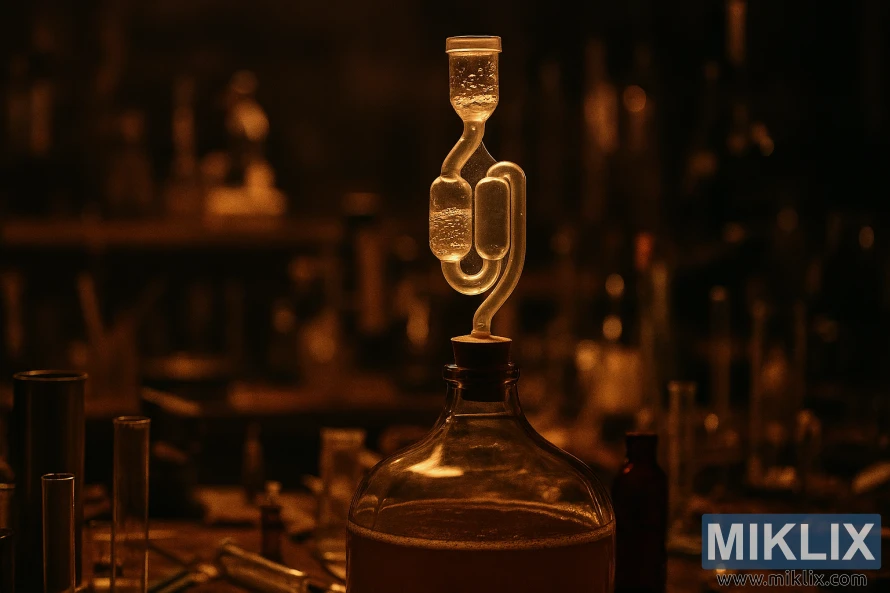
Recipe examples and practical homebrew guides
Below are two tested approaches for a classic bière de garde: a full all-grain recipe and a simpler extract recipe with specialty grains. Both aim for a rich malt backbone, gentle spice from hops, and a clean fermentation profile.
All-grain example (5 gallons)
- Target: OG 1.067, FG 1.015, ABV ~7.1%, IBU ~20, SRM ~14.
- Grist: 8 lb MFB Pilsner, 2 lb Vienna, 1 lb Munich II, 8 oz Caramel Vienna 20L, 6 oz Caramel Munich 60L, 2 oz Carafa III (debittered).
- Hops: Brewer’s Gold 60 min (bittering), Strisselspalt 15 min (aroma).
- Yeast: Wyeast 3725-PC recommended; WLP072 or SafLager W-34/70 acceptable substitutes.
- Mash: step-infusion per Gordon Strong example; if using step mash, hit 131°F for protein rest then raise to 152°F for saccharification. Aim mash pH 5.5 and add CaCl2 to adjust water.
- Ferment: 68°F for primary, crash and lager at 32°F for 4–6 weeks to round flavors.
Extract recipe with specialty grains (5 gallons)
Use light liquid malt extract as the base. Steep 1–1.5 lb Caramel Vienna, 8 oz Caramel Munich 60, and a small amount (1–2 tsp) of debittered black malt for color. Boil 60 minutes with the same hop schedule and yeast options as above.
Follow the same fermentation and conditioning routine. An extract recipe produces a reliable Jenlain clone impression when hopped and fermented correctly.
Practical adjustments for homebrewers
If you lack step-mash equipment, a single infusion at 152°F for 60 minutes will still yield a dry, balanced beer. Up to 10% simple sugar can be added to the fermenter to dry the finish but expect reduced malt complexity.
If Wyeast 3725 is unavailable, consider WY1007, WLP072, WLP570, or WLP011 for similar ester profiles. Lager strains may be used at warmer lager temperatures to mimic the style without extended cold storage.
Fermentation notes and starter guidance
For liquid yeasts plan a healthy starter to hit original gravity quickly. If using ale strains, ferment cooler at 55–60°F to keep esters restrained. For true lager strains, ferment in the 55–60°F range for primary, then lager cold as noted above.
These recipes and tips offer a practical path to brew a faithful bière de garde recipe or a workable Jenlain clone at home. Adjust mash schedules and yeast choices to match equipment and desired flavor emphasis.
Serving, packaging, and aging for best results
When selecting packaging, align it with your objectives. Opt for bottles for a classic look or kegs for ease and uniformity. Commercial breweries often employ champagne-style corking. Homebrewers, on the other hand, might opt out of corks to avoid cellar or musty faults from subpar cork quality.
Early planning on carbonation is crucial. Aim for carbonation levels between 2.3 and 2.6 volumes for a quintessential mouthfeel. Gordon Strong suggests around 2.5 volumes for a harmonious balance between malt and effervescence.
Bottle conditioning bière de garde necessitates precise priming and patience. Begin with a sugar dose of roughly 3/4 cup corn sugar for a five-gallon batch. Allow bottles to condition at room temperature until carbonation stabilizes. Then, move them to cold storage to refine and mellow flavors.
Corked bottles provide a traditional aesthetic and pair well with wired cages for security. Corks are optional for homebrewers. If using corked bottles, select high-quality corks. Store them upright during the initial conditioning weeks to minimize musty notes.
Serving bière de garde at the optimal temperature unveils its malt layers and subtle yeast esters. Pour into a tulip or goblet at 45–55°F (7–13°C). These glasses enhance aroma, support a lasting head, and ensure a clean presentation.
Aging enhances integration. Cold conditioning or lagering for four to six weeks can soften harsh sugars and round the profile. Higher ABV versions benefit from extended bottle aging. This allows alcohol and malt to meld, but be cautious of introducing cork-derived cellar notes.
- Packaging: bottles or kegs, optional corked bottles for tradition
- Carbonation volumes: target 2.3–2.6, classic at ~2.5
- Bottle conditioning bière de garde: prime, room temp conditioning, then cold storage
- Serving bière de garde: 45–55°F in tulip or goblet glassware
Conclusion
Wyeast 3725-PC summary: This strain is crafted for a clean, malt-forward bière de garde. Homebrewers aiming for authenticity should focus on yeast health. This includes planning starters and ensuring adequate cell counts.
Attention to yeast health minimizes the risk of slow fermentation. It also helps preserve the style's subtle caramel and toasty malt notes.
For fermenting bière de garde, cool, controlled fermentation is key. A step or fermentable mash schedule is crucial for a dry finish. Hopping should be restrained, and soft, low-carbonate water enhances malt complexity.
If 3725 is not available, alternatives like WLP072, WY1007, WLP011, SafLager W-34/70, or WY2124/2206 can be used. Adjust fermentation temperatures for a clean profile.
Best practices for Wyeast 3725 include proper yeast handling and temperature control. Avoid rapid temperature swings to prevent off-flavors. A 4–6 week lagering period is recommended for rounding and clarity.
Follow the provided recipe frameworks, whether all-grain or extract. These guidelines will help you achieve a smooth, traditionally styled bière de garde with consistent results.
Further Reading
If you enjoyed this post, you may also like these suggestions:
- Fermenting Beer with White Labs WLP838 Southern German Lager Yeast
- Fermenting Beer with CellarScience Nectar Yeast
- Fermenting Beer with White Labs WLP850 Copenhagen Lager Yeast
